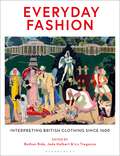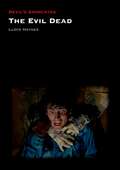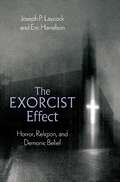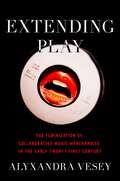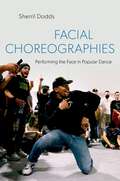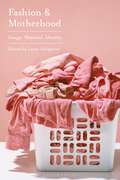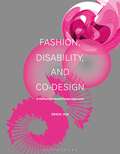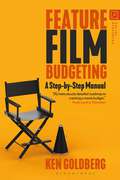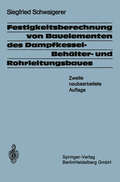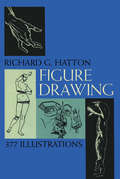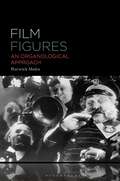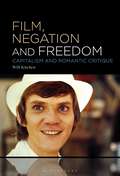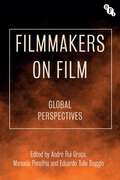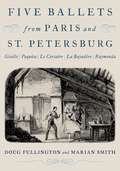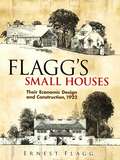- Table View
- List View
Everyday Fashion: Interpreting British Clothing Since 1600
Ordinary clothes have extraordinary stories. In contrast to academic and curatorial focus on the spectacular and the luxurious, Everyday Fashion makes the case that your grandmother's wardrobe is an archive as interesting and important as any museum store. From the moment we wake and get dressed in the morning until we get undressed again in the evening, fashion is a central medium through which we experience the world and negotiate our place within it. Because of this, the ways that supposedly 'ordinary' and 'everyday' fashion objects have been designed, manufactured, worn, cared for, and remembered matters deeply to our historical understanding.Beginning at 1550 – the start of an era during which the word 'fashion' came to mean stylistic change rather than the act of making – each chapter explores the definition of everyday fashion and how this has changed over time, demonstrating innovative methodologies for researching the everyday. The variety and significance of everyday fashion cultures are further highlighted by a series of illustrated object biographies written by Britain's leading fashion curators, showcasing the rich diversity of everyday fashion in British museum collections. Collectively, this volume scratches below the glossy surface of fashion to expose the mechanics of fashion business, the hidden world of the workroom and the diversity and role of makers; and the experiences of consuming, wearing, and caring for ordinary clothes in the United Kingdom from the 16th century to the present day. In doing so it challenges readers to rethink how fashion systems evolve and to reassess the boundaries between fashion and dress scholarship.
The Evil Dead (Devil's Advocates)
by Lloyd HaynesSam Raimi’s The Evil Dead (1981) is one of the most inventive and energetic horror movies of the last 40 years. Released during a period in which the stalk-and-slash cycle had blunted the horror genre of much of its creative edge, Raimi’s debut feature transcends its small budget and limited resources to deliver a phantasmagoric roller-coaster ride, a wildly absurd and surreal assault on the senses. Still original enough to stand on its own and be considered as a genre classic, this book will explain its long-lasting appeal and impact. After detailing the unique circumstances of its origin, Lloyd Haynes goes on to analyse key aspects of the film’s abiding success. The Evil Dead is one of a number of horror films which locate their terrors in a single setting and limited time frame. Haynes argues that it creates a ‘bad dream’ effect in which the nightmare is never-ending and increasingly horrific, and how the cabin-in-the-woods location is also a fine example of the ‘bad place’ motif which stretches back to the Gothic novels of the 18th century. The book goes on to consider what character traits Ash Williams, The Evil Dead’s ‘macho’ male hero, shares with Carol Clover’s ‘Final Girl’ model and how effective he is as a ‘Final Guy’. Finally, it explores the critical approaches to the film, in particular its notorious reputation in Britain as a ‘video nasty’.
Ex Voto
by Samuel ButlerSamuel Butler's Ex Voto (1888) is an account of the author's visit of Sacro Monte at Varallo-Sesia. He describes the Italian landscape as well as the art, history and architecture of the places he visits. Butler compares these sacred places to Jerusalem and also provides details of Tabachetti's remaining work at the Sanctuary of Crea.
The Exorcist Effect: Horror, Religion, and Demonic Belief
by Joseph P. Laycock Eric HarrelsonThe Exorcist Effect is a fascinating historical study of the ongoing relationship between horror movies and Western religious culture, with a focus on the period from 1968 to the modern day. Taking its name from the 1973 film The Exorcist, which was widely understood to be based on a true story, this book outlines a cycle in which religious beliefs and practices become the basis of films that in turn inspire religious beliefs, practices, and experiences in response. Authors Joseph P. Laycock and Eric Harrelson draw heavily from archival research to shed new light on the details of this phenomenon, in addition to incorporating interviews with horror authors, film writers, and paranormal investigators. Drawing on psychology, sociology, and folklore studies, Laycock and Harrelson theorize how film informs religious experience and shapes religious culture. The Exorcist Effect examines the production and reception of Rosemary's Baby (1968), The Exorcist (1973), and The Omen (1976) as seminal films in the genre; figures as Malachi Martin as well as Ed and Lorraine Warren, who inserted themselves directly into the spotlight, and the horror films that influenced and were inspired by their careers; and areas of culture where the influence of this cycle was most apparent-the Satanic Panic, religious exorcisms, and moral panic over heavy metal and the messages it was purported to spread. The final chapter considers the QAnon conspiracy theory and its numerous allusions to film as a contemporary manifestation of ?The Exorcist effect.? Ultimately, The Exorcist Effect is a deftly researched and compelling volume that is sure to interest horror buffs, religious scholars, and historians alike.
Experimental Film and Queer Materiality
by Juan A. Su?rezOften described as an art of abstraction and subjective introspection, experimental film is also invested in exploring daily objects and materials and in channeling, in the process, a peculiar perception of the modern everyday that this book calls queer materiality. Queer materiality designates the queer latency of modern material culture, which often inspired queer artists and filmmakers to envision wayward bodies and behaviors, and refers to the way in which sexual and social dissidence was embedded in the objects, technologies, substances, and spaces that make up the hardware of experience. This book studies a rich archive of queer material engagements in work by well-known filmmakers such as Andy Warhol, Barbara Hammer, Carolee Schneemann, and Jack Smith as well as under-recognized figures such as Tom Chomont, Jim Hubbard, Ashley Hans Scheirl, and Teo Hern?ndez. Combining history, formal analysis, and theoretical reflection, author Juan A. Su?rez shows how plastics, glitter, mechanical ensembles, urban ruins, garbage, amphetamine, film grain, and noise have been mobilized in the articulation of queerness for the screen. Experimental Film and Queer Materiality is an inquiry into the liveliness of matter and into the interface between sexuality and the material world.
Exporting Japanese Aesthetics: Evolution from Tradition to Cool Japan (The Liverpool Library of Asian & Asian American Studies)
by Tets Kimura Jennifer HarrisExporting Japanese Aesthetics brings together historical and contemporary case studies addressing the evolution of international impacts and influences of Japanese culture and aesthetics. The volume draws on a wide range of examples from a multidisciplinary team of scholars exploring transnational, regional and global contexts. Studies include the impact of traditional Japanese theatre and art through to the global popularity of contemporary anime and manga. Under the banner of soft power or Cool Japan, cultural commodities that originate in Japan have manifested new meanings outside Japan. By (re)mapping meanings of selected Japanese cultural forms, this volume offers an in-depth examination of how various aspects of Japanese aesthetics have evolved as exportable commodities, the motivations behind this diffusion, and the extent to which the process of diffusion has been the result of strategic planning. Each chapter presents a case study that explores perspectives that situate Japanese aesthetics within a wide-ranging field of inquiry including performance, tourism, and visual arts, as well as providing historical contexts. The importance of interrogating the export of Japanese aesthetics is validated at the highest levels of government, which formed the Office of Cool Japan in 2010, and which perhaps originated in the 19th Century at governmentally endorsed cultural courts at worlds fairs. Increased international consumption of contemporary Japanese culture provides a much needed boost to Japans weakening economy. The case studies are timely and topical. As host of the 2020 Tokyo Olympic Games and the 2025 Osaka Expo, Cool Japan will be under special scrutiny.
Extending Play: The Feminization of Collaborative Music Merchandise in the Early Twenty-First Century
by Alyxandra VeseyDespite the hypervisibility of a constellation of female pop stars, the music business is structured around gender inequality. As a result, women in the music industry often seize on self-branding opportunities in fashion, cosmetics, food, and technology for the purposes of professional longevity. Extending Play examines the ubiquity of brand partnerships in the contemporary music industry through the lens of feminized labor, to demonstrate how female artists use them as a resource for artistic expression and to articulate forms of popular feminism through self-commodification. In this book, author Alyxandra Vesey examines this type of promotional work and examines its proliferation in the early 21st century. Though brand partnerships exist across all media industries, they are a distinct phenomenon for the music business because of their associations with fan club merchandise, concert merchandise, and lifestyle branding, often foregrounding women's participation in shaping these economies through fan labor and image management. Through textual and discourse analysis of artists' songs, music videos, interviews, social media usage, promotional campaigns, marketing strategies, and business decisions, Extending Play investigates how female musicians co-create branded feminine-coded products like perfume, clothes, makeup, and cookbooks and masculine-coded products like music equipment as resources to work through their own ideas about gender and femininity as workers in industries that often use sexism and ageism to diminish women's creative authority and diminish the value of the recording in order to incentivize musicians to internalize the demands of industrial convergence. By merging star studies, popular music studies, and media industry studies, Extending Play proposes an integrated methodology for approaching contemporary cultural history that demonstrates how female-identified musicians have operated as both a hub for industrial convergence and as music industry professionals who use their extramusical skills to reassert their creative acumen.
Eyes Wide Shut: Behind Stanley Kubrick's Masterpiece (Stanley Kubrick Studies)
Twenty years after its release, Stanley Kubrick's Eyes Wide Shut remains a complex, visually arresting film about marriage, jealousy, domesticity, adultery, sexual disturbance, and dreams. This was the final enigmatic work from its equally enigmatic creator. It has left an indelible mark on our popular culture and remains as relevant as ever. Much maligned and much misunderstood when it first came out, Eyes Wide Shut has since been the subject of an animated debate and discussion among critics, fans and academics. It has been explored from a wide variety of disciplines and methodological perspectives. This collection brings scholars from diverse disciplinary backgrounds together with those who worked on the film to explore Eyes Wide Shut’s legacy, discuss its impact, and consider its position within Kubrick’s oeuvre and the wider visual and socio-political culture.
Facial Choreographies: Performing the Face in Popular Dance
by Sherril DoddsThe face contributes a vital, yet often overlooked, component of dance performance. Facial Choreographies: Performing the Face in Popular Dance examines what the face does in dance and what it may mean. Author Sherril Dodds focuses on popular presentational dance, which permits the face to be one of excess and spectacle, as well as disclosure or deception. The concept of facial choreography resists the idea that the expressive countenance in dance is simply by chance, and instead conceives its movement as purposeful, creative, and communicative. The book centers on three facial case studies: global celebrity Michael Jackson, whose face has occupied a site of fervent controversy; Maddie Ziegler, child star of the reality television series Dance Moms and de facto face of pop star Sia; and a community of hip hop dancers who engage in fiercely contested dance battles. Chapters are organized according to action-expressions, actively working even in times of stillness: SMILE, LOOK, FROWN, CRY, SCREAM, and LAUGH. Across each case study, the book explores pedagogies of facial composition, the purpose of codified expressions, and how dancers re-choreograph their faces as a critical unworking of what a dancing visage might represent. Facial choreographies engender opportunity for startling creativity, the articulation of identity, a cathartic expression of emotions and attitudes, and the capacity to dismantle previously held assumptions. As the dancing face tauntingly slips between visual, sensory, and kinetic registers it ensures that nothing can be taken at face value.
Fancy Dresses Described: A Glossary of Victorian Costumes
by Ardern HoltThe Victorians adored fancy-dress parties: what better way to escape the rigidity of social conventions than to spend a festive evening disguised as Cleopatra, a Swiss milkmaid, or Alice in Wonderland? Well-to-do party-goers of the era consulted Fancy Dresses Described, an elaborate guide to hundreds of glorious costumes. The book was so popular that it was updated several times; this is the sixth and final edition, originally published in 1896. Time has transformed it into an important historical document as well as an abundant cosplay resource. Twenty color and 40 black-and-white illustrations enhance the alphabetical entries, which are mostly for women's costumes but include a section on children's dress. Costumes range from the peasant garb of Austria, Italy, and Ireland to the finery of the six wives of Henry VIII, Marie Antoinette, and other members of French and English royalty. Additional entries spotlight characters from Shakespeare and Dickens; traditional apparel of Egypt and ancient Greece and Rome; Cinderella, Maid Marian, and other folkloric figures; as well as outfits suggested by astronomy, the seasons, the animal kingdom, and other thematic subjects. Costume designers, reenactors, lovers of Victorian fashion, and Halloween enthusiasts will find this historic volume a tremendous source of inspiration.
Fashion and Motherhood: Image, Material, Identity
Motherhood, whether achieved through biological or other means, is not a rare experience; dressing oneself, even less so. The two phenomena are intimately linked, as both occur on and to the private body, and are also fully subject to social pressures and the changing tides of public opinion. They also, for anyone who experiences motherhood, define one another and work together to shape an individual's identity and place in their culture.This rich collection explores the essential question of how motherhood and fashion interact, interrogating their relationships to power, misogyny, temporality, longing and embodiment, among other themes. The 13 essays examine representations on film, in popular print and literature; they use images, narrative and material evidence from the past to excavate the historical cleavages in how mothers have been expected to hide, display, share and sacrifice their bodies. An international range of scholars explores the 19th to the 21st centuries, tracing how fashion and motherhood have operated as powerfully interdependent experiences and continue to determine how women are judged and corralled, yet also find meaning, connection and strength.
Fashion, Disability, and Co-design: A Human-Centered Design Approach
by Grace JunConstricting styles and limited clothing choices can restrict a person with a disability from fully participating in social communities, employment and gatherings that have an unspoken dress code. Design has the power to change this.Fashion, Disability, and Co-design shows how collaborative, inclusive design techniques can produce garments and accessories that increase social inclusion. Grace Jun outlines practical techniques to help designers create their own inclusive collections, with detailed examples from interviews with professionals. 14 illustrated case studies show how engagement with disability communities to co-design clothing and accessories can lead to functional, wearablesolutions for people of all abilities without compromising style.Interviews:- Inclusive Representation in Fashion Narrative & Design Process – Christina Mallon- Understanding the Use of Materials – Angela Domsitz Jabara- Human Factors and Occupational Therapy – Michael Tranquilli- Interactive Garments and Textiles – Jeanne Tan
Feature Film Budgeting: A Step-by-Step Manual
by Ken GoldbergFeature Film Budgeting: A Step-by-Step Manual is a step-by-step guide to film budgeting in the $600k to $6.5 Million range. Be it the film student, Line Producer, 1st Assistant Director, or script writer, all will benefit from the easy-to-follow steps on how to create a film budget. This book walks the reader through how to:- find current and future salary rates for every Hollywood Guild- determine Prep and Wrap periods for all crew members- navigate the Guild contracts for easy understanding- analyze salary rates and how they were arrived at- simplify the application of fringe rates (tax percentages). Additionally, sample budgets are presented to reinforce knowledge gained in each chapter through a comprehensive breakdown. Notably, this manual covers films budgeted in the $600,000 to $6.5 Million range. This allows the reader to focus and excel at those budget levels before moving on to higher budget levels.
Female Art and Agency in Yugoslavia, 1971–2001
by Anja FoerschnerDespite having become marginalized on the map of contemporary art since the wars of the 1990s, the regions of former Yugoslavia continue to be a hub of creative activity. Especially noteworthy is the strong presence of women artists, scholars, and activists whose deeply personal, yet highly political artwork is rooted in a long legacy of female artistic agency. Building on existing scholarship as well as original research, this book highlights how female figures – through art and exhibition making, writing, mentorship, and activism – have shaped the alternative art scene in former Yugoslavia and placed the region firmly on the map of the international post-avantgarde.Using the founding of the Student Cultural Center Belgrade in 1971 as a starting point, the book details the pioneering work of women in the realm of curation, where they developed radical exhibition concepts and programs that furthered the development of the New Art Practice and embedded Yugoslavia firmly on the map of the international postwar-avantgardes. It highlights the agency of female artists in the then-novel realms of performance art, video art, and new media art and shows how their work has helped these disciplines to gain the impact they retain until the present day. What is more, it shows how female cultural workers have courageously used their work to further the discourse on gender, sexuality, and the female body and, at a time when they saw themselves stripped of basic rights by the chauvinist-nationalist regimes emerging after Yugoslavia's breakup, formed a strong artistic and activist opposition. Highlighting the role of women in the diversification of the ex-Yugoslavia states and its highly unique cultural and political landscape, this book addresses the noticeable gap in art historical scholarship that exists not only around Yugoslavia and its successor states, but especially on its female representatives.
Festigkeitsberechnung von Bauelementen des Dampfkessel-, Behälter- und Rohrleitungsbaues
by S. SchwaigererDie deutschen Vorschriften und Richtlinien für die Berechnung von 1 Dampfkesseln und Druckbehältern beschränken sich bewußt auf die Wiedergabe der einfachen und kurzen Berechnungsformeln. Hinter die sen Formeln stehen jedoch die Ergebnisse wissenschaftlicher Unter suchungen und einer ausgedehnten laufenden Forschung, die immer wieder durch praktische Erfahrungen erhärtet und ergänzt bzw. auch korrigiert· werden müssen. Es ist Herrn Dr. SoHWAIGERER dafür zu dan ken, daß er der Anregung des Deutschen Dampfkessel- und Druckgefäß Ausschusses gefolgt ist und die theoretischen Grundlagen des deutschen Berechnungswerkes und die Entwicklung, die hierzu geführt hat, zu sammenfassend niedergelegt hat. Als langjähriger Mitarbeiter von Herrn Professor Dr. -Ing. ERIOH SIEBEL war er wohl dazu berufen, die Sie bel sehen Ideen darzulegen, die dem Deutschen Dampfkessel- und Druck gefäß-Ausschuß in besonderem Maße als Richtschnur für seine Arbeiten in den beiden letzten Jahrzehnten gedient haben. Die Ausführungen von Herrn Dr. SoHWAIGERER bieten nicht nur die theoretische Grundlage und Bestätigung für die zur Zeit geltenden und zum Teil noch im Entwurf vorliegenden Berechnungsregeln, sondern zudem auch eine wünschenswerte sachliche Kritik und V arschläge für die weitere Entwicklung und Ergänzung. Die Technik des Dampfkessel und Druckgefäßbaues ist noch in ständigem Fluß. Die Bestrebungen und Vorschläge für eine Regelung aufinternationaler Ebene verdienen dabei besondere Beachtung. Deshalb ist die vorliegende Zusammenstellung nicht nur als Grundlage für die derzeitig geltenden Vorschriften und Richtlinien zu begrüßen, sondern darf auch als Ausgangspunkt für deren weitere Entwicklung angesehen werden.
Figure Drawing: A Complete Guide (Dover Anatomy for Artists)
by Richard G. HattonWhile there are any number of anatomy texts and handbooks for artists, this is one of the few available studies that approach the art of figure drawing from the point of view of the draftsman. Though it does provide a fund of information on all important anatomical features and functions, the book stresses how the figure-sketcher should handle his subject, how he should actually put down surface lines and prominences on paper. It is an immensely practical guide for the student. The text covers all aspects of drawing the human form. An important introductory section deals with methods of drawing and the proper proportioning of the body. Then the author treats the various parts of the body in full detail: head and neck (over 100 pages on facial features, etc.), the trunk (chest, abdomen, vertebral column, breast, pelvis, shoulders, etc.) and the upper and lower limbs and digits. A final discussion takes up the topic of drapery, the main points of support on the body, and various styles of representing the folds and forms of garments. Three hundred seventy-seven figures, mostly sketches by the author, but including some examples from classical times and famous artists, illustrate the text. These figures show undraped men and women of all ages and types in various positions and movements and from all angles (full front view, profile, three-quarter view, rear view, etc.) so that the coverage is as thorough as possible for the student. Other drawings show and identify muscles and elements of the skeletal system and indicate their relation to surface contours. A clear and readable account with many helpful suggestions on sketching technique, the book offers a nontechnical, inexpensive home-study course or supplementary text for the beginning artist. Those art students who derive little or no benefit from anatomy courses would do well to study this volume. Unabridged, unaltered republication of original edition.
Film Figures: An Organological Approach
by Warwick MulesFilm Figures develops a figural account of the memory structure of films.Employing theoretical concepts drawn from a range of sources, including French post-humanist philosophy and German Idealism, the book undertakes an organology of film guided by the work of Bernard Stiegler whose philosophy of mnemotechnesis provides the framework of analysis. Situating films in the quantum field of spacetime relativity as a field of cosmic views, inquiry into film figures begins with disturbances in the experience of films themselves, posing questions of the relation between the dead past and the living future in film story-telling. By breaking the façade of the continuing present through self-questioning, we open films to their figural dimensions in the counter-movement of drive as negentropic resistance. Following the back-movement of drive switches our perception to the figural register in which characters become figures probing blindly for what the film will have been in another time – a time yet to be lived. By following the anterior possibilities of this other time, we open films to the archival future in which a new future comes forth. This book provides theoretical and analytical concepts as well as strategies for taking a step into this future, guided by questions of the right path to take given the relativity of views in which the film can be experienced. Films analysed include Murnau's The Last Laugh, Capra's It's a Wonderful Life, Hitchcock's Rear Window, Welles's The Lady from Shanghai, Fellini's Intervista, Antonioni's L'Eclisse, Bresson's Une Femme Douce, and Zeller's The Father.
Film, Mobility and Urban Space: A Cinematic Geography of Liverpool
by Les RobertsDrawing on multi-disciplinary debates surrounding the cultural production of place, space and memory in the post-industrial city, Film, Mobility and Urban Space explores the role of moving images in representations and perceptions of everyday urban landscapes. The arguments put forward in the book are based on a case study of Liverpool in the north west of England and draw from a unique spatial database of over 1700 archive films of the city from 1897 to the present day. Theoretically wide-ranging in scope, Les Roberts’s study combines critical spatial analysis, archival research and qualitative methods to navigate a city’s cinematic geographies as mapped across a broad spectrum of film genres, including amateur film, travelogues, newsreels, promotional films, documentaries and features. As the second most filmed city in the UK – and formerly second city of Empire – Liverpool boasts a rich industrial, architectural and maritime heritage that has positioned the city – which was European Capital of Culture in 2008 – at the forefront of current debates on regeneration, visuality and cultural memory. The tension between the city as spectacle and the city as archive, and the contradictions that underpin the growing ‘cinematization’ of postmodern urban space are at the core of the arguments developed throughout the book. Examining the contention that, as spatial practices, the production and consumption of urban cinematic geographies are, in their different ways, tied to shifting cultures and geographies of mobility, Film, Mobility and Urban Space maps the critical interplay between material and immaterial spaces of the city and re-evaluates the significance – and ‘place’ – of location in contemporary film practice and urban cultural theory.
Film Nation: William Troy on the Cinema, 1933-1935
by James R RussoNotable writers on literature and culture who occasionally penned opinion pieces on the movies prior to World War II include Clifton Fadiman, Mark Van Doren, Lincoln Kirstein, Edmund Wilson, Louise Bogan, and Paul Goodman. All of these critics wrote seriously about things other than the movies. Indeed, the early decades of film criticism drew many moonlighters who tried their hand at it for a few years, then moved on to their preferred metier. And such was the case with William Troy (1903-1961). Troy, a distinguished literary critic whose posthumous Selected Essays won a National Book Award in 1968, was also a much-loved professor at Bennington College, the New School, and New York University. Troy was the film critic of The Nation from 1933 to 1935. To that post he brought an educated, almost professional tone, which he sometimes used for comic effect. He approached each piece of film criticism as an occasion for some larger essayistic rumination. Indeed, his feeling for the carpentry of the short review is superb, as the reader will detect in his pieces on such important films as Buñuel's L'age d'Or, Lang's M, Duvivier's Poil de Carotte, Eisenstein's Que Viva México!, Dreyer's The Passion of Joan of Arc, Cocteau's Blood of a Poet, Pudovkin's Mother, Flaherty's Man of Aran, Renoir's Madame Bovary, and Ford's The Informer. William Troy was thus one of Americas first full-time professional film critics, if not the best of the lot. He deserves some of the attention heretofore reserved for another important early critic, James Agee, who himself began writing movie reviews for The Nation in 1942. Published in conjunction with The Bookman: William Troy on Literature and Criticism, 1927-1950 (ISBN 978-1-78976-172-6), Film Nation is essential reading for cinephiles. Inclusion of a substantive index makes the work highly attractive for classroom adoption in the field of cinema studies.
Film, Negation and Freedom: Capitalism and Romantic Critique
by Will KitchenFilm, Negation and Freedom: Capitalism and Romantic Critique explores cinema in relation to the critical tradition in modern philosophy and its heritage in Romantic aesthetics. Synthesising a variety of discursive fields and traditions - including Early German Romanticism, Frankfurt School critical theory and the aesthetic philosophy of Jacques Rancière - Film, Negation and Freedom outlines a radical new approach to film by re-examining the work of Arthur Penn and Lindsay Anderson. A distinction between Light and Dark Romanticism is introduced as a means of interpreting cinema's relationship with capitalism, as well as dualistic concepts such as stillness and motion, passivity and activity, pain and pleasure. Film, Negation and Freedom revitalises our understanding of modern audio-visual media, as well as the aesthetic, philosophical and political conditions of Romantic subjectivity, artistic practice and spectatorship.
Filmmakers on Film: Global Perspectives
by André Rui Graça Eduardo Baggio Manuela PenafriaThis book bridges the gap between film theory and filmmakers' thoughts and poetics, and proposes a new way to address and elaborate film theory.It brings together primary sources by filmmakers themselves, drawing on their films, interviews, books, texts, and manifestos. Divided into three parts, the book covers the main aspects of this approach. Part one discusses the concepts of 'author' and 'filmmaker'. Part two evaluates the creative processes of a broad range of filmmakers, including Víctor Gaviria (Colombia), Kleber Mendonça Filho (Brazil), Jean-Luc Godard and Agnès Varda (France), Abbas Kiarostami (Iran) Pa. Ranjith (India), Andy Warhol (USA), Maya Deren (Ukraine-USA) and Nuri Bilge Ceylan (Turkey). The final part examines filmmakers' various techniques, particularly the use of multi-images, after-(dialectical)-images, and the use of sound as a sensorial and narrative tool. This curated selection of writings, with contributors from a range of countries including the USA, UK, India, China, Portugal, Brazil, Belgium and New Zealand, reflects the global perspective of this new approach. The volume also discusses the ways in which filmmakers influence each other, the spectator as seen by filmmakers, and ways to critically address a filmography that takes into account filmmakers other than the director.
The Films of Apichatpong Weerasethakul
Delving into Apichatpong Weerasethakul’s films, this book uncovers a plethora of conceptual paradigms. Apichatpong's films frequently utilize rural Thailand as a backdrop, showcasing daily life, interactions, rituals, and customs, all infused with a Southeast Asian essence. This utilization of local imagery provides a national quality to his works, allowing a global audience to explore both urban and rural aspects of Thai society, along with discourses on history, culture, politics, and practices. Beyond the surface, the films also address universal and intricate themes, transcending cultural boundaries. The book delves into a range of lesser-explored aspects regarding the films and filmmaking of Apichatpong, developing fresh perspectives on the representation of nonhumans, hybrid forms, transmedia plot, technique, production among others. With meticulous analyses of his key works this interdisciplinary study unveils the threads that bind Apichatpong’s creative practice, innovative techniques, and philosophical insights. An essential read for cinephiles, scholars, and seekers of cinematic depth, this book uncovers the vibrant tapestry of meaning within Apichatpong’s enigmatic film-worlds.
The Films of Michael Mann: From the Prison Wall to the Firewall
by Deryck SwanIs Michael Mann an auteur? Mann is a formidable filmmaking personality, no doubt, but the notion that today's celebrity cult of director immediately correlates with the mysterious sect of 'auteur' is questionable and deserves to be investigated. In doing so this book strives to emulate the methodology of the man himself, by ranging over not only the films he has made, from 1979’s The Jericho Mile to 2015's Blackhat, but also the scope of intellectual interests that they exemplify in an attempt to mine the commonalities, themes and traits that may suggest the presence of an auteur. Through his investigation of Mann's filmography and the personality that flows through it, author Deryck Swan provides the reader with accessible and new ways of thinking about his films to date, including, amongst myriad other things, references to painter Morris Louis, desert modernism, West Coast prison culture, Chicago Mayor Richard M. Daley, Strain Theory, journalist Mike Royko, Chicago's Auditorium building and a largely forgotten Charles Bronson film.
Five Ballets from Paris and St. Petersburg: Giselle | Paquita | Le Corsaire | La Bayad?re | Raymonda
by Marian Smith Doug FullingtonFive Ballets from Paris and St. Petersburg offers fascinating new looks at five classic story ballets: Giselle (1841), Paquita (1846), Le Corsaire (1856), La Bayad?re (1877), and Raymonda (1898), drawing on a treasure trove of manuscripts that offer explicit written information about how many nineteenth-century ballets were performed in their earliest incarnations. Bursting with details forgotten for more than a century, these manuscripts bring the ballets to life by disclosing steps, floor patterns, and mime conversations as well as valuable insight into how the music helped create the drama. Generously enriched with more than 50 images and more than 350 musical examples, the book also includes, in appendices, English translations of seven French and Russian librettos. Emerging from the plenteous new findings in this book is a fresh portrait of a living, breathing art form with strong audience appeal. Simply put, Five Ballets fills huge gaps in dance history, inviting both general readers and specialists to rethink the usual narratives about nineteenth-century ballet, its music, characters, and choreographies, its depictions of Others and Elsewhere, and the careers of its major choreographers. It also offers a rich resource to practitioners seeking to learn how the makers of these five classic ballets found such great success.
Flagg's Small Houses: Their Economic Design and Construction, 1922
by Ernest FlaggA celebrated New York architect and designer of the city's fabled Singer Building, Ernest Flagg (1857-1947) was most famous for his skyscrapers. But Flagg was also an ardent proponent of the well-designed single-family dwelling. As this classic treatise illustrates, he devised a variety of structural economies and ingenious innovations.Filled with 526 blueprints, photographs, and other illustrations, Flagg's Small Houses embraces modular designs, the use of ridge-dormers, and saving space, materials, and costs. Flagg offers advice on every corner of the home, from the practicalities of plumbing and heating to the aesthetics of color choices and landscaping designs. Modern designers, both professional and amateur, will find this book a timeless source of advice and inspiration.
